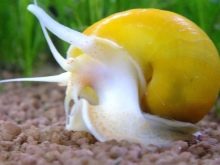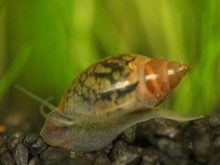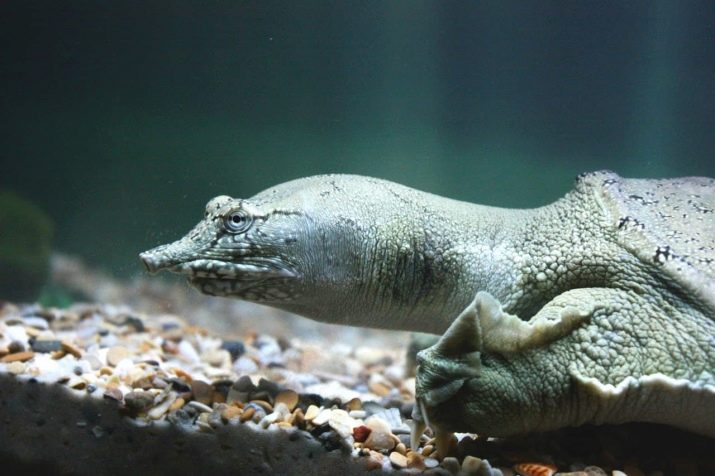Aquarium inhabitants: types and tips for choosing

Uncommon, but there are home aquariums, which, in addition to fish, contain other inhabitants of the aquatic space. Although this is not something out of the ordinary, but such an aquarium immediately becomes the object of everyone's attention. It is interesting for everyone to look at some living specimens of the underwater world, which many have seen only in photographs. Let's talk in this article about what unusual aquarium animals can live in home aquariums, as well as what kind of maintenance they need.


Popular types
Probably, in the first place in the list of the most popular unusual inhabitants of aquariums it is worth putting snails. They are most often seen in the home of amateur aquarists who have not yet gained much experience in their field. Snails give the mini-reservoir a natural look, and also cleanse it of various debris, mucus, food residues, and dead inhabitants. In other words - the benefits of them are significant. But they can also cause considerable harm, for example, by eating up the vegetation of a home reservoir.
Among the aquarium snails, one can name the following species: the beautiful ampullaria, fiza, tropical neretina, nighttime activity melania and many others.



Most snail species do not require any unusual maintenance techniques. They have only one requirement - to the temperature and purity of the water. But each snail has its own survival parameters, often with overlapping values. So it is quite possible to choose a cohabitation of different species of snails. At the same time, it is better not to place carnivores and herbivores in one place. It happens that when the aquarium is heavily populated with herbivorous snails, predatory snails called helena are launched to them, which bring the mini-pool ecosystem back to normal.

Crabs also become frequent inhabitants of aquariums, as some species of them get along quite well with fish. But for them you need to purchase a separate feed and build stone apartments. Besides, crabs literally gut the soil and dig in the vegetation.
This should be taken into account when choosing flora for your aquatic nursery. Keep in mind that crabs are shoot champions, so keep your aquarium tightly closed.

Dwarf orange cancer - another arthropod inhabitant of aquariums, who fell in love with his peacefulness towards other inhabitants of the underwater kingdom and does not do any harm to its flora. There are no special problems with the maintenance, except for the rather spacious living space - for one individual, a tank volume of at least 70 liters is required. And since this small arthropod creature, the size of which does not exceed 5 cm, eats almost everything, then there will be no problems with feeding.

Newts ordinary ones will decorate any underwater space with their presence. These creatures have an unusual color, which becomes even brighter in females during the mating season, and in males at this time a very noticeable ridge on the back stands out. There are some other types of newts, for example, spiny, comb, each of which is interesting in its own way, but they all love worms, tadpoles and insects.
There is one nuance in their content: for newts, a separate house is needed, which is called an aquaterrarium. Aquatic lizards periodically need to go on land.


Some fish species and other inhabitants of the aquarium can become neighbors frogs... But, of course, not those ordinary creatures from the nearby pond, but prettier individuals, whose homeland is exotic overseas countries. For example, clawed frogs from Africa are very popular among aquarists. They have attracted even novice amateurs to create the underwater world at home. Such individuals do not require access to land, like many other amphibians, and have an original appearance.


They got their name from one feature - on three toes of the hind legs of this frog there are sharp claws, therefore these creatures were called clawed.
Such frogs are predators, therefore, it is undesirable to keep them in the same aquarium with small fish species. It is better for them to allocate a separate reservoir in which a group of such frogs, consisting of several females and one male, can be placed (animals do not like competition). Frogs love to feast on the delicate leaves of aquatic vegetation and dig in the ground. Need a weekly cleaning of the frog aquarium with the exchange of 1/5 of the water. The water temperature should be at 21-25 degrees.



Rare inhabitants
Among the very unusual inhabitants for home aquariums, one can name the following rare guest. Octopus - this creature with numerous tentacles can really be considered the most outlandish inhabitant of a home aquarium. The unusual interest in this deep-sea creature can also be explained by the mysterious stories, legends and myths associated with it, which are innumerable in scientific and fictional literature, cinema and other sources.
The only pity is that these magnificent representatives of sea cephalopods in home conditions live for a short century - only 1 to 3 years at best.
That is why in some states it is forbidden to keep octopuses in home aquariums, except for those that were born in captivity.


The maintenance of this deep-water inhabitant is not cheap at all, since:
- the octopus itself costs a lot of money;
- he needs a huge aquarium with a volume of at least 0.3 cubic meters;
- such an aquarium needs a powerful filter;
- eats only expensive live food: shrimp, shellfish, crabs and other seafood;
- he has an excellent appetite.
Most often purchased for home maintenance Californian two-spotted and Atlantic pygmy octopus.


The first of them also belongs to the dwarf species of this mollusk.
You can also make a small list of extraordinary inhabitants of aquariums, meeting with whom your friends and acquaintances can be considered a great success.
- Rainbow crab. This, it seems, the most unusual animal among all arthropods is called everywhere differently: indigo, tricolor, patriot, land crab. He comes from the west coast of Africa, where he huddles in burrows and among stones. His carapace is painted blue, his legs are orange, and his belly is white with bluish veins. In captivity, crabs live from 7 to 10 years, eat meat, various fruits and vegetables. To keep them, you need an aquarium of strict dimensions (60x45x45) and good water, which needs to be slightly salted.

- Amano shrimp. A freshwater shrimp of small size (4-5 cm), which attracts aquarists with its bright appearance and mobility. They get along well in aquariums with small species of fish, which are smaller in size and are not aggressive.

- Trionix... This creature is a Chinese soft-bodied turtle with an unusual shell, devoid of the usual horny shields. The shell of these turtles is covered with a kind of "cloak" of ordinary skin cells. But on the other hand, she has strong and fast paws, equipped with claws, as well as sharp tooth strips. Unlike other turtles, Trionix moves quite briskly. To comfortably keep this turtle with sizes from 20 to 35 cm, you need an aquarium of at least 250 liters.

Selection Tips
The problem of choosing exotic, rare and unusual inhabitants of aquariums for the home arises due to the fact that there is no one to consult with - you can count on one hand the professionals in this matter. You can only rely on the sellers - perhaps there will be an intelligent consultant among them. On the other hand, who will describe his product from the bad side? The most realistic option may be mining information on the Internet on forums on the topic of aquariums and keeping unusual animals in them.
In addition, you can visit the local zoo, where you will surely find a specialist in such matters.

For our part, we can recommend the following:
- before choosing, first think about your idea from all sides: who did you decide to have as an unusual pet, what kind of equipment does he need for a comfortable existence, do you have the opportunity to create conditions for life, full feeding and reproduction of such an individual;
- find information about the basic rules for the care and maintenance of a pet, and think if you can adhere to them;
- ask the seller or from external sources about the "pitfalls" of the content and diseases of your future pet;
- Observe the animal in the store for a while to find out how it behaves when surrounded by other inhabitants of the aquarium or alone.
For possible inhabitants of the aquarium, see below.








